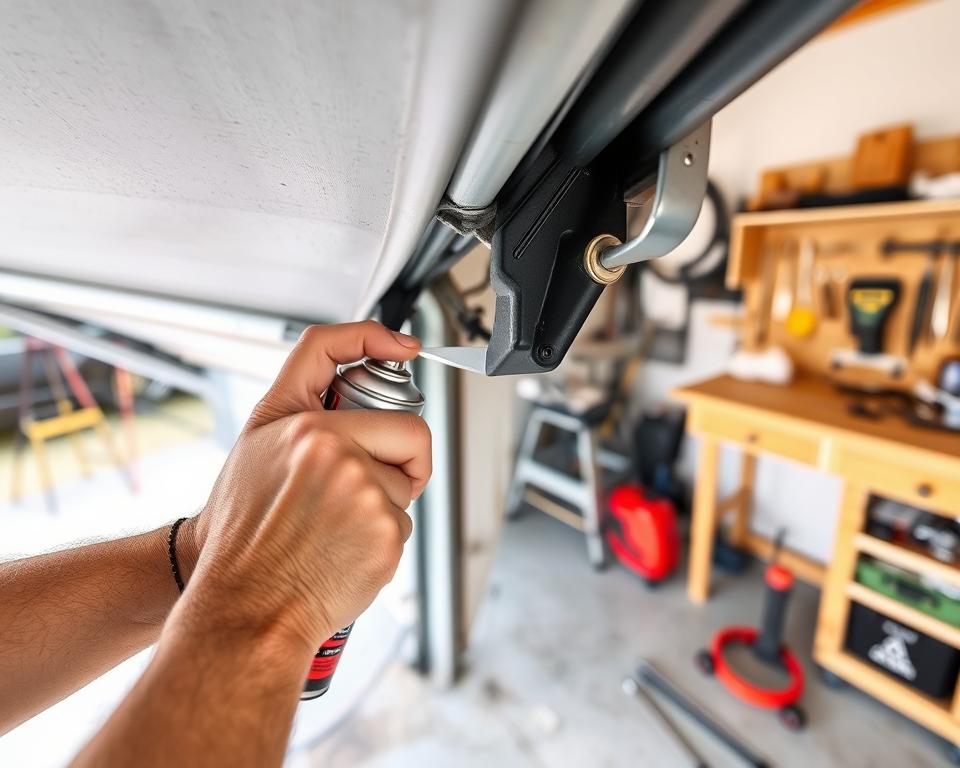Garage door maintenance is key for a door that works well and lasts. You should lubricate garage door parts around 2-3 times a year. This is based on how often you use it and the weather. If you hear grinding sounds, it’s time to lubricate.
If you use your garage a lot or live in a place with extreme weather, you’ll need to do it more often. Parts like springs, rollers, and hinges need lubrication every three months. Rails, however, only need it once a year.
Not lubricating your garage door can cause damage. This damage can be costly to fix. To keep your garage door running smoothly and quietly, follow the suggested lubrication schedule.
Understanding the Importance of Lubrication
Lubricating your garage door regularly is key for smooth and quiet working. It cuts down friction between moving parts. This not only makes the door work better but also stops problems before they start. Doing this will make your door last longer and work like it’s supposed to.
Why Lubrication Matters
Lubricating your garage door has many benefits. It makes the door quieter and more pleasant to use. Especially in the morning or at night, a noisy door can be a hassle. Regular lubrication helps avoid this issue.
Also, it stops wear and tear on important parts like hinges and springs. When these parts move smoothly, they don’t get stressed or damaged easily. Lubrication also keeps them from getting rusty, which is great for areas with lots of moisture or extreme temperatures.
Longevity and Smooth Operation
Lubricating a garage door also makes it last longer. It lessens friction and wear, so the door works well without breaking down. This means you won’t have to fix it as often.
Use silicone or lithium-based lubricants for the best care. These stay effective in different temperatures. WD-40 Specialist White Lithium Grease Spray and Blaster Chemical Company Premium Silicone Lubricant are good options. They keep your door moving smoothly.
It’s best to lubricate garage doors every six months. But if your door is used a lot or if the weather is extreme, you might need to do it more often. Regular checks will tell you when it’s time for more lubricant. This will keep your door quiet and extend its life.
Factors Influencing Lubrication Frequency
The need to lubricate your garage door hinges depends on several things. These include the weather, how often you use the door, and the kind of lubricant you choose. Knowing these things can help keep your garage door working well.
Climate Conditions
Weather plays a big role in how to care for your garage door. In places with harsh weather like Tracy, CA, you should lubricate every three months. Temperature changes make metal parts expand and shrink, needing more lubrication.
Also, wet weather can cause rust. Lubricating helps protect against this damage.
Frequency of Use
How often you use your garage door also affects its upkeep. In busy homes or businesses, monthly lubrication might be needed. More use means more wear and tear, leading to the need for more maintenance.
Type of Lubricant Used
It’s crucial to pick the right lubricant for your garage door. Use silicone or lithium sprays, but not WD-40 since it’s a cleaner, not a lubricant. The right choice means you won’t have to lubricate as often.
In summary, consider the climate, how often you use the door, and choose the correct lubricant. Doing these things will help extend the life of your garage door. It ensures it operates smoothly all year.
General Lubrication Schedule
Keeping up with your garage door lubrication schedule is essential. It ensures your door works smoothly and lasts longer. Doors that are not maintained can develop problems in just a few years. However, a well-lubricated door can work well for up to 30 years. Regular checks and listening to how your door sounds are advised.
Yearly Lubrication Recommendations
Data suggests that garage doors need lubricating at least twice yearly. Important parts like hinges, rollers, springs, locks, and the rail’s top need this the most. Lubricating these parts reduces rust, cuts down on friction, and helps avoid early problems.
Using silicone sprays is smart for tough-to-reach spots and helps in cold weather. White lithium grease fights rust and works well in different weather conditions. It’s perfect for various climates.
Signs Your Garage Door Needs Lubrication
Spotting problems early can prevent costly fixes. Watch out for these signs:
- Squeaking or Grinding Noises – These sounds often mean parts need more lubrication to move smoothly.
- Slow or Uneven Movement – A door that doesn’t open or close right may need lubricating.
- Visible Wear or Corrosion – Rust or damage on metal parts usually means it’s time for lubrication.
- Operational Failures in Extreme Temperatures – Lubrication helps parts move well in both cold and hot weather.
If you use your garage door a lot, especially as the main entry, lubricate it more often. Following these maintenance tips for garage doors will keep your door working well for years.
Pre-Lubrication Maintenance Tips
Before you start lubricating, it’s important to follow a good garage door maintenance checklist. Doing this makes sure the lubrication works well and improves the door’s performance. Let’s look at some important steps to take before lubrication:
- Inspect and Tighten Hardware: Make sure all nuts and bolts are tight. Loose parts can cause more damage, making preparing for garage door lubrication very important.
- Examine Worn Parts: Check for wear on springs, rollers, and cables. Pay extra attention to the door rollers as they can gather dirt.
- Clean the Tracks: Dirt and debris in the tracks can stop the door from working smoothly. Clean these tracks well before putting on any lubricant.
- Test Safety Features: Do tests on balance and the mechanical reverse feature. If the door falls when released, get help right away. This is a main part of any garage door maintenance checklist.
- Inspect Springs: The springs have a lot of tension. Check for signs of wear. If needed, carefully use penetrating oil on them.
- Weather Seals: Look at the weather seals for any signs of damage or wear. Change them if needed for better insulation and less noise.
- Photocell Alignment: Make sure the door photocells are lined up right along the beam. This ensures they work as they should.
- Adjust Drive Chain/Belt: The drive chain or belt should be a quarter inch from the rail’s bottom. This stops breakage and makes sure the door works smoothly.
- Check for Rust and Corrosion: Keep an eye on the door for rust and stop corrosion, especially on metal parts. Using grease well can help a lot with this.
Following these pre-lubrication maintenance tips helps keep your garage door working its best. It makes sure the lubrication lasts longer and is more effective. Remember, getting ready before you lubricate is key. It makes the difference in preparing for garage door lubrication and helps your garage door parts last longer.
Best Lubricants for Garage Doors
Picking the right garage door lubricant can make your door last longer and work better. Different lubes offer various benefits. They help keep the system moving smoothly without attracting dirt. Making the right choice is key to avoid any issues.
Silicone-Based Lubricants
Silicone lubricants are a top choice because they work well in all temperatures, from very cold to very hot (-58°F to 600°F). They don’t pull in dirt and help parts move easily. But, be careful when using near car paint as they might cause damage.
White Lithium Grease
White lithium grease is great for many temperatures (-60°F to 350°F) and lasts a long time. It’s good for spots that stay in place, like door hinges, and won’t make a mess. It also keeps the door quiet by preventing metal from rubbing on metal.
Avoiding the Wrong Products
Choosing the best lubricant isn’t just about what you use, but also what you should avoid. Stay away from heavy greases and products like WD-40. They can attract dirt and cause the door to wear out faster. Picking and using the right lube helps the door stay in good shape.
Experts suggest you should lubricate your garage door every 3 to 6 months. This depends on how often you use it and the weather.
| Lubricant Type | Temperature Range | Primary Benefits |
|---|---|---|
| Silicone-Based Lubricants | -58°F to 600°F | Reduces friction, does not attract dirt |
| White Lithium Grease | -60°F to 350°F | Stable, long-lasting protection |
| PTFE Lubricants | -80°F to 400°F | Non-stick, high temperature resistance |
The Pitfalls of Using WD-40
One key reason against WD-40 for garage doors is it’s mainly a solvent. This means it only provides short-term lubrication. Garage doors need lubrication every three to six months, but WD-40 requires frequent reapplication. This makes it impractical for proper garage door maintenance.
WD-40 also tends to attract dirt and grime to your garage door’s moving parts. This can increase wear and shorten the lifespan of your door’s opener. It adds more strain to the motor through increased friction.
Moreover, WD-40 can harm rubber, plastic, or nylon parts of garage doors. This can cause the parts to break down faster. It leads to higher maintenance costs and potential failures, showing WD-40 is not a good choice.
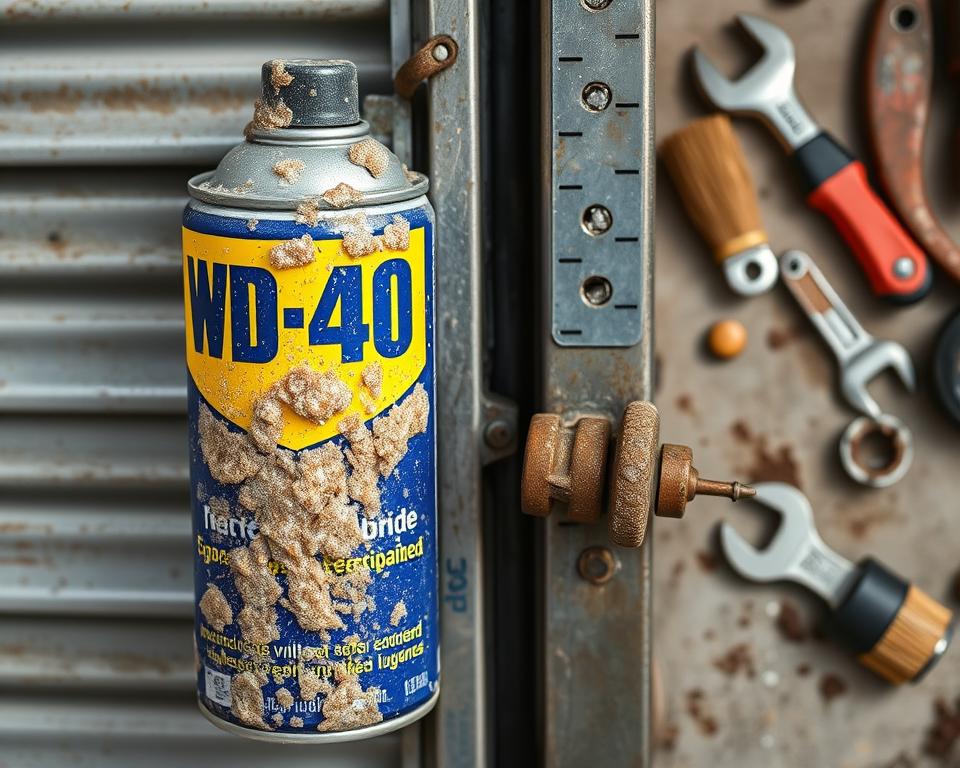
| Lubricant | Characteristics | Application Frequency | Material Compatibility |
|---|---|---|---|
| WD-40 | Solvent, temporary lubrication | Every few days | Can degrade rubber, plastic |
| White Lithium Grease | Thick, water-resistant, long-lasting | Every 3-6 months | Safe for metal, plastic, rubber |
| Silicone Spray | Quick-drying, rust prevention | Every 3-6 months | Safe for all materials |
In summary, the WD-40 limitations highlight the product’s unsuitability for garage doors. Choosing specialized lubricants like white lithium grease or silicone spray is more effective. It extends the life of your garage door and avoids extra repairs. Ultimately, this saves both time and money for homeowners.
How to Lubricate Garage Door Tracks
Keeping your garage door tracks in good shape is key for them to work well. This means you need to clean garage door tracks and apply garage door lubricant. We will cover how to do these steps so your door runs smoothly.
Cleaning the Tracks
Clean the tracks before adding lubricant. This helps your garage door work right. Start with a damp cloth to wipe down the tracks. Get rid of visible dirt and grime.
For deeper cleaning, a vacuum works well. It can get rid of dust in tight spots. Cleaning garage door tracks properly lets the lubricant stick better. This makes your door run smoother.
Applying the Lubricant
After cleaning, it’s time to grease the tracks. Use a good lubricant, like lithium grease or silicone lubricant. These help prevent door problems. But only use a little. Too much grease makes dirt stick, which can cause issues. Spread a thin layer on the tracks. Then, open and close the door to spread the lubricant well.
Here’s what you need to know about lubricants:
| Type of Lubricant | Benefits | Drawbacks |
|---|---|---|
| Silicone-Based | Works in many temperatures, less friction | Costs more |
| White Lithium Grease | Lasts long, fights rust | Can pull in more dirt if you use too much |
| Standard Oil | Cheap, simple to use | Not for long-term, draws dust |
To keep your door working well, Clopay suggests using Clopay Garage Door Pro Lube or a synthetic oil. Doing regular cleaning garage door tracks and applying garage door lubricant helps your door last longer. It also saves you money on repairs.
Lubricating Garage Door Rollers
Lubricating your garage door rollers correctly keeps your door running smoothly. It’s vital to know how different rollers work for effective lubrication.
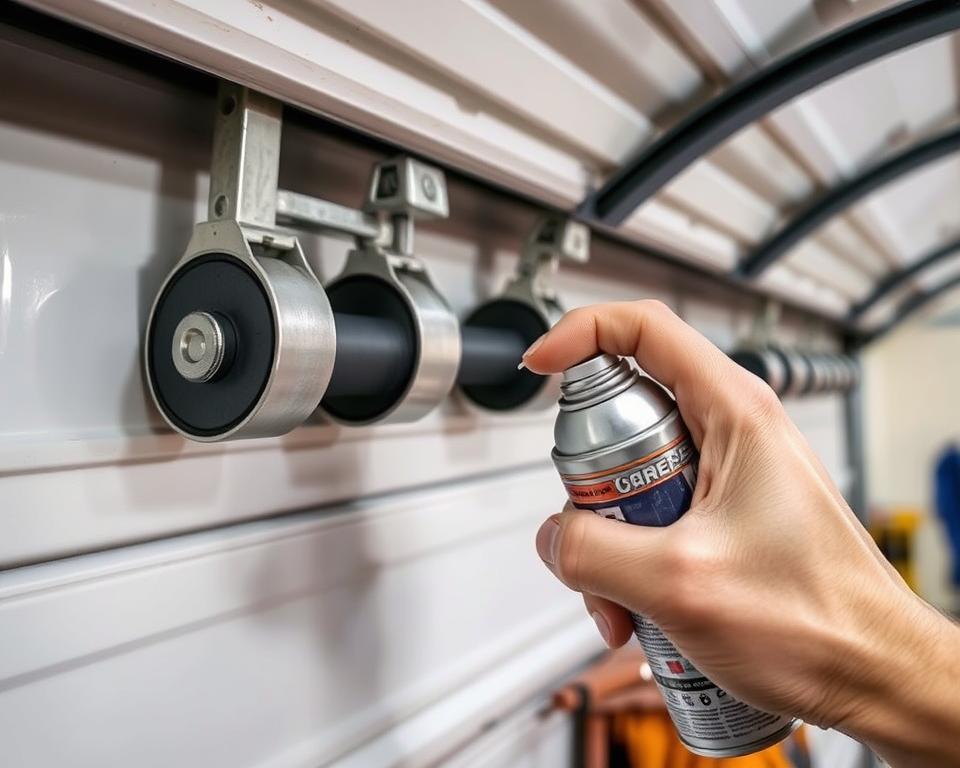
Types of Rollers: Steel vs. Nylon
Garage door rollers come in steel and nylon, each with its own needs:
- Steel Rollers: These are tough but can be noisy. Lubricate both the roller and its bearings well.
- Nylon Rollers: They are quieter and last longer. However, only the bearings need lubricating to avoid hurting the nylon.
Step-by-Step Roller Lubrication
- Inspect the Rollers: Look for any damage or wear.
- Clean the Rollers: Remove any dust or grime for better lubrication.
- Apply the Lubricant:
- For steel rollers, use lithium-based or silicone-based lubricant on the roller and bearings.
- For nylon rollers, only put lubricant on the bearings to protect the nylon.
- Distribute the Lubricant: Move the door up and down to spread the lubricant evenly.
Follow these steps to keep your garage door working well. Remembering the differences between roller types helps you take care of them better.
Hinges and Their Role
Hinges are essential for your garage door to move smoothly. By inspecting and oiling them, you avoid problems like creaking or stiffness. This care keeps the hinges working well and lasting longer.
Inspecting and Lubricating Hinges
Check your garage door hinges every six months to keep them in top shape. Look for any wear, rust, or damage. Use silicone or lithium grease for lubrication, not WD-40, as it’s more of a cleaner. Spread a bit of grease on the hinge joints to cover all moving parts. This step is key in keeping your garage door hinges in good condition.
Common Problems with Hinges
Maintaining your hinges well can prevent bigger issues. Rust and wear can make hinges stiff or misaligned. If there’s still noise or trouble after oiling, it might be time for professional help. Keeping hinges in shape is crucial for your garage door’s health.
Importance of Lubricating Springs
Garage door springs are key for a smooth, balanced door movement. It’s important to regularly lubricate them. This prevents risks and keeps them working well.
Identifying Spring Types
It’s important to know the types of garage door springs for upkeep. There are torsion and extension springs mostly.
- Torsion Springs: These lie horizontally above the door’s opening. They help lift the door by using torque. This balances the door’s weight, crucial for its smooth operation.
- Extension Springs: You’ll find these at the garage door’s corners. They stretch and contract to balance the door’s weight. Unlike torsion springs, they don’t need lubrication to work well.
Springs: Lubrication Method
Lubricating garage door springs is simple and extends their life. Torsion springs should be lubricated twice a year. Use white lithium grease or silicone spray for this. These products make a thick coating. This is better than using WD-40, which might dry them out and lead to failure sooner.
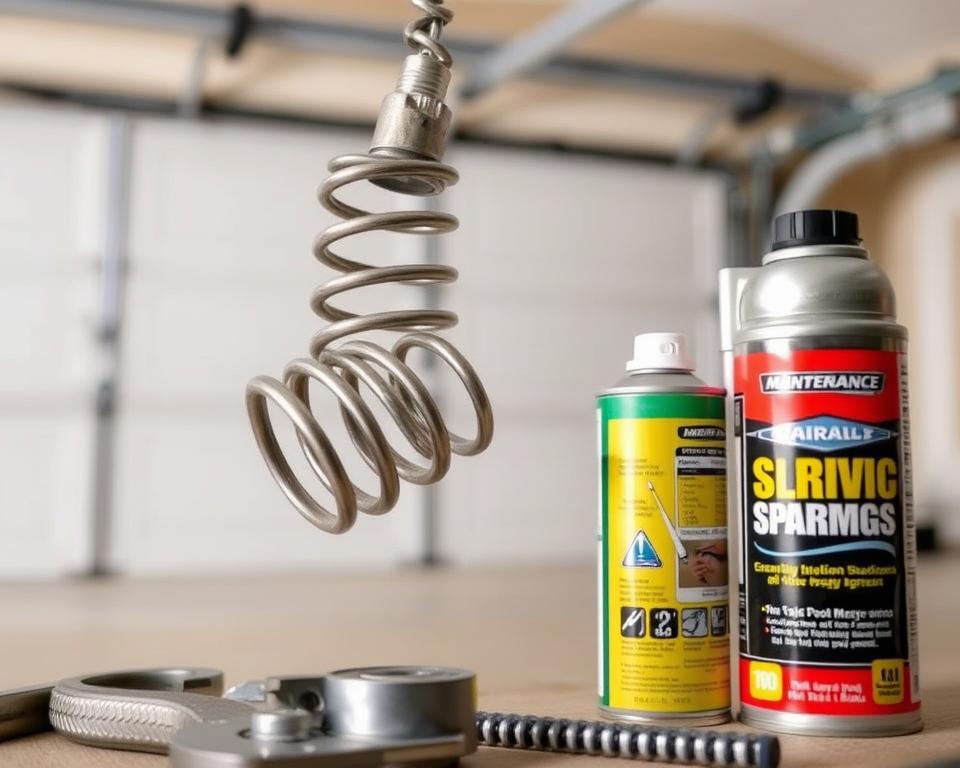
| Spring Type | Position | Lubrication Frequency | Best Lubricants |
|---|---|---|---|
| Torsion Springs | Horizontal above opening | Twice annually | White lithium grease, Silicone spray |
| Extension Springs | Corners of the door | None required | — |
Keeping up with garage door spring maintenance is essential, like with any home appliance. Proper lubrication stops noises, decreases wear and tear, and makes your garage door safer.
Manual Lock and Armbar
Maintaining manual door locks is crucial but often ignored. Keeping them well-lubricated is key to comprehensive garage door care. Lubricating your locks regularly helps prevent sticking, boosting both security and usability.
When it comes to lock maintenance, using the right lubricant is key. Spray lubricants are great for reaching tough spots. It’s essential to pick one that suits your climate.
In cold areas, silicone-based lubricants work best. For warmer places, try lithium-based grease. This choice makes a big difference.
Ammar Hanafieh, a pro with years of experience, highlights frequent lubrication. It helps avoid rust, corrosion, and dirt. This care makes manual garage door parts last longer and work better.
Here’s why lubricating your garage door lock matters:
| Lubricant Type | Suitable Climate | Key Benefits |
|---|---|---|
| Silicone-Based | Cold | Non-greasy, works well in low temperatures |
| White Lithium Grease | Warm | Durable, fights rust |
| Oil-Based | Variable | Handles temperature shifts, extends life of mechanisms |
Regularly oiling the armbar and lock stops small problems from becoming big repairs. Keeping up with door lock care ensures they work smoothly. It also makes your garage door system last longer.
Top of the Rail Lubrication
Lubricating your garage door’s top rail is very important. It makes sure the door moves smoothly and doesn’t wear out the opener’s trolley. The top rail guides the trolley to open and close the door. Without the right lubrication, the rail can cause a lot of friction. This may lead to the door not working right and expensive fixes.
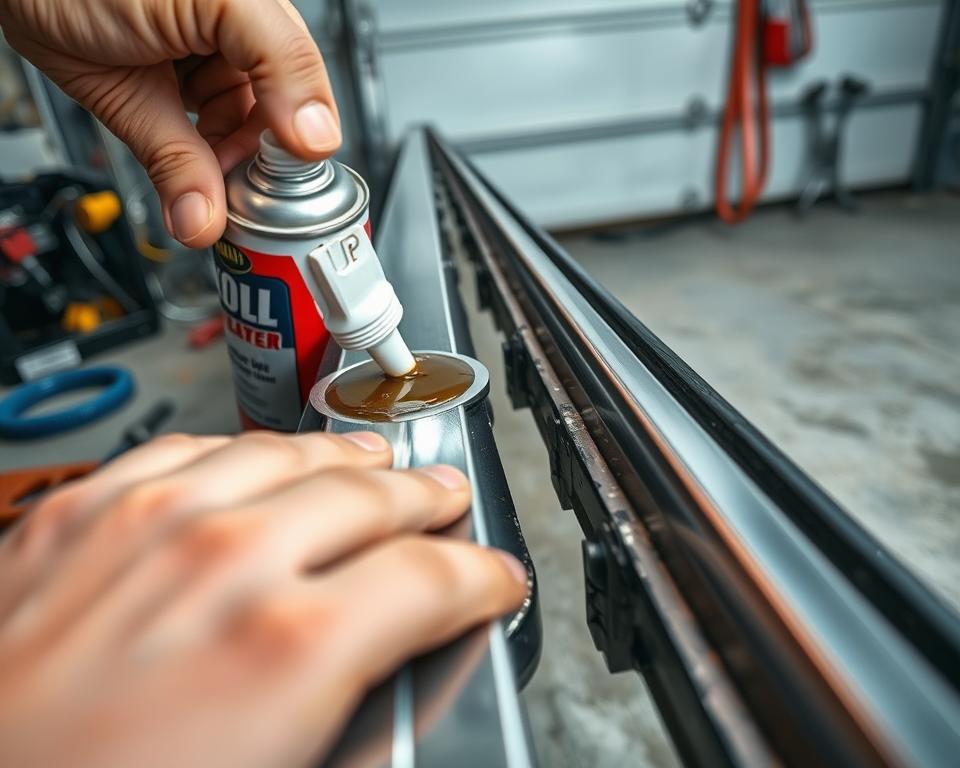
Why It’s Necessary
Keeping garage door rails lubricated keeps everything running well. Without it, dirt builds up, causing more resistance and less efficiency. Eventually, this could harm the garage door opener or shorten its life. Proper lubrication makes sure all parts mesh well, reducing strain on the motor.
How to Properly Apply Grease
Here is how you start applying grease right:
- Clean the Rail: First, clean off any dirt from the rail using a dry cloth. It’s important to not let any grime mix with your lubricant.
- Apply Lubricant: Choose a top-grade silicone or white lithium grease. Spread a thin, even layer all along the top rail.
- Spread Evenly: Open and close the door by hand a few times. This helps the grease cover the rail evenly.
- Wipe Excess: Last, clean up any leftover lubricant. You don’t want dirt sticking to the rail, as it ruins the lubrication’s effect.
Lubricating your garage door rails regularly is key to a long-lasting door. It’s a good idea to do this about every six months. Following this routine keeps your door in top shape and prevents sudden failures.
How to Lubricate a Garage Door Opener Chain
Lubricating opener chains is vital for your garage door. It keeps the door working smoothly, increases its life, and cuts down on noise. A well-kept opener can last up to 30% longer. Ignoring this can lead to a 15% hike in energy use.
- Disconnect Power: Always turn off the garage door opener first. This prevents it from accidentally turning on.
- Clean the Chain: Wipe the chain with a clean cloth. Remove dust, debris, and old lubricant.
- Apply Lubricant: Choose a lubricant made for garage doors. Silicone-based or white lithium grease work well. Don’t use WD-40 as it’s not right for this job.
- Spread Evenly: Move the door manually after applying lubricant. This ensures it covers the whole chain.
- Check the Sag: The chain should not sag more than 1/2 inch. Adjust it if you need to.
- Reconnect Power: After you’re done, plug the power back in.
Do this maintenance every 6 to 12 months. It reduces wear on the door parts and can lower repair bills by 40%. It also makes the door quieter by 50%. This keeps your system efficient and quiet.
About 70% of issues with garage door openers come from not maintaining them. Sadly, 25% of homeowners don’t do this regular upkeep. By lubricating opener chains and keeping up with maintenance, you’ll improve your garage door opener’s performance and life.
| Benefit | Percentage |
|---|---|
| Improved Lifespan | 30% longer |
| Energy Efficiency | 15% less consumption |
| Noise Reduction | 50% less noise |
| Reduced Repair Costs | 40% less |
Common Mistakes in Garage Door Lubrication
Keeping your garage door well-lubricated is key for its smooth operation and longevity. But, some common mistakes can mess up your maintenance efforts. This can lead to expensive repairs. It’s important to follow a good care routine and avoid making these lubrication errors.
Over-Lubrication Issues
Lubricating your garage door too much is a common error. This might seem like a good idea, but it’s not. Too much lubricant can attract dirt and debris. This causes a greasy buildup. This buildup can make components sticky and cause grinding noises, which hampers smooth operation.
For homes, it’s best to lubricate the door every six months. Commercial or frequently used doors may need lubrication every three months.
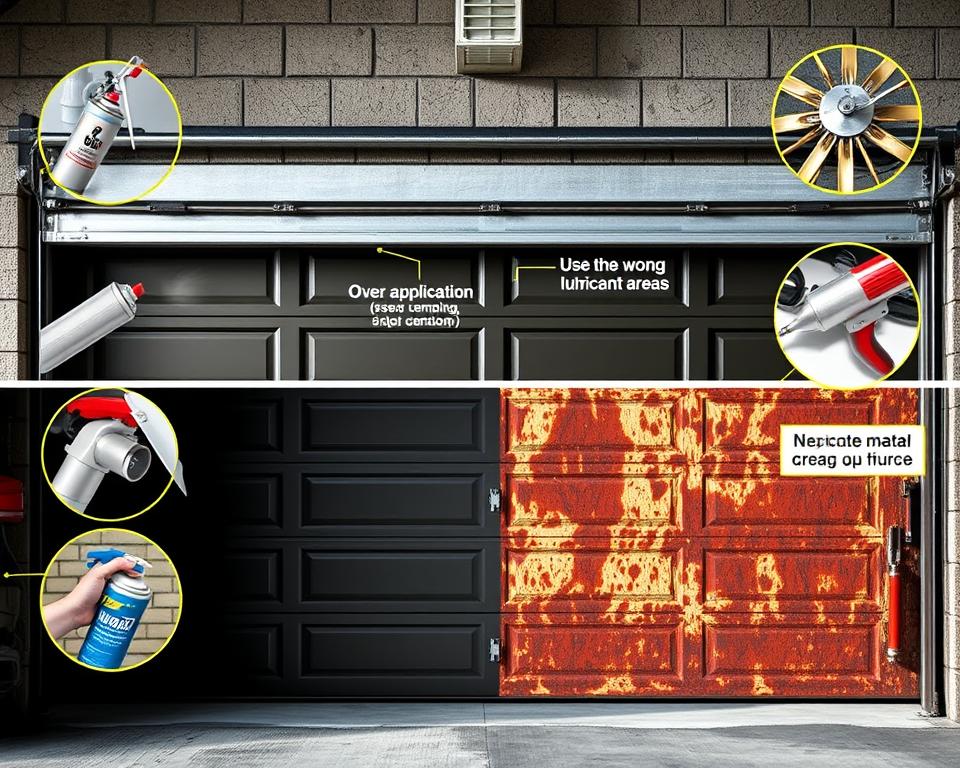
Using too much lubricant can also cause ugly grease spots. It’s better to use silicone-based or white lithium grease. These reduce wear and tear without leaving too much residue.
Forgetting Key Components
Another mistake is skipping important parts when lubricating. Good garage door care means looking after all moving parts. This includes the hinges, rollers, and springs. Leaving them out can cause them to wear out faster and break down sooner.
Checking and lubricating these parts regularly keeps them running well. This lowers the chance of them breaking down. Sometimes, bad weather or high humidity means you need to lubricate more often than usual.
Here’s a summary of the key points:
| Mistake | Consequence | Solution |
|---|---|---|
| Over-Lubrication | Grease buildup, sticky components, grinding noises | Use appropriate lubricant amount and types |
| Neglecting Components | Increased wear, early malfunctions | Ensure all parts are lubricated |
| Ignoring Environmental Factors | Operational inefficiencies, frequent maintenance | Adjust lubrication frequency based on conditions |
By steering clear of these lubrication mistakes, you keep your garage door in top shape. Following a solid care schedule will extend your door’s life. It ensures it runs smoothly all year round.
Seasonal Maintenance Tips
Proper garage door care all year is key to keep it working right. Each season affects your garage door differently. This guide helps you manage your door’s lubrication in winter and summer.
Winter Lubrication Needs
Winter makes garage door parts stiff, needing more lubrication. Adding more lube stops parts from getting too stiff. This helps it work smoothly. The cold also thickens the lube, so you might need to adjust the opener’s power.
Key winter maintenance tips:
- Use silicone-based lubricants for the cold.
- Lubricate moving parts at least twice in winter.
- Check the weatherstripping to keep your garage warm.
- Make sure the auto-reverse feature works fast for safety.
Summer Lubrication Adjustments
High heat in summer can make lubricants runny and less effective. So, it’s important to check and adjust lube in summer. This prevents overheating and protects the parts.
Key summer maintenance tips:
- Put lube on roller tracks and parts twice in summer.
- Change the batteries in your remote and keypad.
- Replace weather seals to keep your garage sealed tightly.
- Clean the tracks often to stop dirt causing friction.
Following these tips for each season helps your garage door work well all year. It keeps your home safe and convenient.
Expert Advice on Garage Door Lubrication
Having a smooth-operating garage door is key for both ease and longevity. Garage door experts, with years of experience, provide personalized lubrication advice. They consider your door type, local weather, and how often you use it.
Following a regular lubrication schedule is vital, say the pros. Here’s what they suggest:
- Springs should be lubricated every three months to prevent wear and sticking.
- Hinges need oiling every three months, especially in harsh weather.
- Rollers also require lubrication every three months with normal use.
Choosing the right lubricant is crucial to avoid issues. Experts often suggest silicone-based spray lubricants for their ability to withstand extreme temperatures and moisture. They’re great for seeping into tight spots. For parts that touch, like springs and rollers, white lithium grease is better. It lasts long and helps with noise reduction.
Here’s a table that outlines the recommendations on what to use and when:
| Component | Recommended Lubricant | Frequency |
|---|---|---|
| Springs | White Lithium Grease | Every 3 months |
| Hinges | Silicone Spray | Every 3 months |
| Rollers | White Lithium Grease | Every 3 months |
| Chain Drive Openers | White Grease | Every 6 months |
| Belt Drive Openers | Initial Lubrication | Lifespan Coverage |
Using pro tips for garage door upkeep not only makes your door last longer but also saves on repairs. For best results, talk to garage door experts. They can spot and fix hidden problems, helping homeowners avoid future issues.
Conclusion
Understanding the right way to take care of your garage doors is very important. It’s suggested to do *visual inspections* at least every two months. Also, lubricate when parts look dry. This will make sure your garage door works smoothly and quietly. It also makes your garage door last longer.
It’s good to lightly lubricate your garage doors every 3 to 6 months. If you use your garage a lot, or if the weather is bad, you might need to do it more often. Pay extra attention to parts like springs, rollers, and hinges. Tracks and rails need lubrication once a year. By doing this, your garage door will work well for a longer time.
Choose the right lubricant, like silicone-based or white lithium grease, instead of products like WD-40. This is because the right lubricant keeps your garage door working well for longer. Make sure to maintain your door before it gets very hot or cold. This helps avoid damage and keeps your door working safely. By keeping up with these steps, your garage door will work better and last longer.
Source Links
- https://www.abetterdoorny.com/blog/how-often-should-i-lubricate-a-garage-door/
- https://gdmedics.com/how-lubricate-garage-door/
- https://elitegaragelynnwood.us/blog/often-lubricate-garage-door/
- https://artisandoorworks.com/blog/how-to-lubricate-a-garage-door-so-it-isnt-noisy/
- https://www.clopaydoor.com/residential/buyingguide/how-to-properly-lubricate-garage-door-components
- https://raptorgaragedoorsolutions.com/lubricating-your-garage-door-how-often-should-you-do-it/
- https://www.goprogaragedoorrepair.com/how-often-do-you-need-to-lubricate-a-garage-door-in-tracy-ca/
- https://expressgarageparts.com.au/why-and-when-you-should-lubricate-a-garage-door-essential-maintenance-tips/?srsltid=AfmBOopRzMZdlx6omhD6gmKJnymRKhNUJ4NjaeUMi8wZAcKxN2nBmvDC
- https://qualityoverheaddoor.com/blog/how-to-lubricate-your-garage-door/
- https://www.housedigest.com/1564587/how-often-lubricate-garage-door-expert/
- https://www.homedepot.com/c/ah/garage-door-maintenance-tips/9ba683603be9fa5395fab90ea038cc1
- https://thompsongaragedoors.com/how-to-lubricate-a-garage-door/
- https://kingdoor.com/blog/garage-door-lubrication/
- https://www.servicespring.com/garage-door-lubricants-and-choosing-the-right-one/
- https://www.clopaydoor.com/blog/post/blog/2022/08/03/why-you-should-never-use-wd-40-on-a-garage-door
- https://www.sacsgarage.com/choosing-right-garage-door-lubricant/
- https://www.sacsgarage.com/garage-door-track-lubrication-yes-no/
- https://www.hunterdoor.com/blog/how-to-clean-and-lubricate/
- https://canadoorsystems.com/blog/how-to-lubricate-a-garage-door/
- https://www.bobvila.com/articles/how-to-lubricate-garage-door/
- https://utahgaragedoors.net/blog/tips-and-tricks/how-to-maintain-your-garage-door-springs/
- https://dentonoverheaddoor.com/2020/07/how-often-should-you-lubricate-your-garage-door/
- https://precisiondoorla.com/blog/what-are-garage-door-springs-and-how-should-you-maintain-them/
- https://www.safetygaragedoor.com/blog/how-to-lubricate-garage-doors
- https://elitegaragelynnwood.us/blog/faq-items/lubricate-garage-door-best-practices/
- https://www.forestdoor.com/blog/lubricating-garage-doors/
- https://a1garage.com/how-to-lubricate-your-noisy-garage-door/
- https://www.aaronsgaragedoorcompany.com/how-to-lubricate-a-garage-door-5-easy-steps/
- https://premierdoorcorp.com/how-to-maintain-chain-driven-garage-door-openers/
- https://www.lewisdoorservice.com/how-often-do-you-need-to-lubricate-a-garage-door-chain/
- https://www.overheaddoorcompanyofhuntsville.com/how-to-lubricate-your-garage-doors/
- https://abbydoors.co.uk/how-often-lubricate-garage-door/
- https://canadoorsystems.com/blog/seasonal-garage-door-maintenance-tips/
- https://overheaddoormichigan.com/essential-seasonal-maintenance-tips-for-your-garage-door/
- https://todayshomeowner.com/garage/guides/how-to-lubricate-garage-door/
- https://www.soooverheaddoors.com/ca/blog/guide-lubricating-garage-door-prolonging-lifespan
- https://www.houstonoverheaddoor.com/blog/how-often-to-grease-garage-door/
- https://raynordoor.com/a-guide-to-lubricating-your-garage-door/

